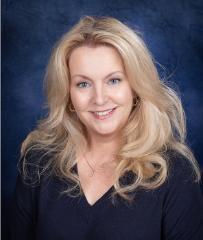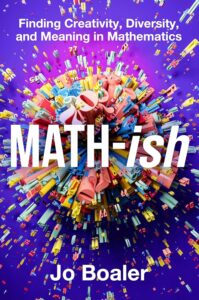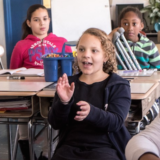What MATH-ish Can Add to Your Math Classes
Math-ish: Finding Creativity, Diversity, and Meaning in Mathematics
By Jo Boaler
(Harper Collins, 2024 – Learn more)
Reviewed by Kathleen Palmieri

Dr. Boaler is the Nomellini & Olivier Professor of Education at Stanford University, specializing in mathematics learning. She co-founded youcubed.org which provides educators, students, and parents with resources to engage, excite, and inspire students about mathematics. Dr. Boaler is currently co-leading a K-12 Data Science Initiative and was named as one of the eight educators “changing the face of education” by the BBC.

Math-ish?
First, let me start by saying this is not your typical professional text on math. Boaler uses real life experiences and weaves mathematical teachings into the stories she shares. The writing flows and the words help to provide visuals in the reader’s mind. It is conversational in tone, and when a new term such as “-ish” was introduced and defined I found myself easily grasping its meaning.
“I will use the term mathish,” Boaler writes, “to describe a way of thinking about the mathematics we use in the real world that could be a powerful tool for student thinking. Embracing these concepts of mathematical diversity and of math-ish are keys to stepping into a rich understanding of mathematics that is equitably meaningful for all learners, regardless of education, gender identity, race, or ethnicity, and beyond.” (pg. 6)
Beyond Narrow Mathematics
Boaler’s discussion of “Narrow Mathematics,” the idea that there is only one way to solve and one answer, rings true because most math curriculums teach a strategy, expect one answer, and as Boaler explains, “They are always numerical, and they do not involve visuals, objects, movements, or creativity.” (pg. 9).
Boaler explains that this narrow approach turns students away from STEM courses and many times prevents students who need to pass a mathematics course from achieving their goals. “Narrow mathematics ends the hopes and dreams of millions of college students. Not only is this a problem for the students, but it also causes severe problems for US society, threatening the future of the economy, the development of science, technology, medicine, and the arts.” (pg. 11)
She argues that we need to move away from this narrow math and think about mathematical diversity, looking at math through many lenses, and helping to make math more visual. We need to offer ways for students to collaborate and share what they are thinking, picturing and possibly solving a particular problem.
Metacognition and Math
Throughout the text, Boaler offers research and ideas from education, cognitive science, neuroscience and psychology.
In Chapter Two, “Learning to Learn,” she discusses the value in metacognition and its impact on students’ achievement. Metacognition is encouraged through eight mathematical strategies that are fully explained in the book. Below is a brief introduction to each: (pages 39-45)
- Take a Step Back: to consider what the problem is asking you.
- Draw the Problem: this helps to create activity in the visual parts of the brain and stimulate important connectivity between numerical and visual areas.
- Find a New Approach: asking students to think of other ways to solve the problem.
- Reflect on Why: having students explain their thinking on a mathematical process.
- Simplify: creating a simpler problem.
- Conjecture: asking students to come up with an idea that has not been proven; it is “still at the idea stage.”
- Become a Skeptic: pairs with students’ work providing conjectures; inviting students to reason and “to take on the role of skeptic.”
- Try a Smaller Case: Boaler considers this strategy a super power. I highly suggest you read on in the book to learn more about this.
Journaling, in which students reflect on their mathematical thinking, is also highly valued. Reflecting on your own learning is an important part of being metacognitive.
The Power of Struggle
“Board the Struggle Bus” in Chapter Three offers the neuroscience of “Brains forming, connecting, and strengthening pathways” (figure 3.1; page 75). Many of us have grown up with the myth that we either have a math brain or we don’t, says Boaler. “There is no such thing as a ‘math brain’; our brains are changing all the time. I want my students to struggle and make mistakes. When we are struggling, it is a really important time for our brains: they are forming, connecting, and strengthening pathways.” (p. 75)
Boaler suggests having a “struggle” conversation with students, and I do this with my own class. I believe it’s important for students to know it’s “okay to not know,” but they need to allow themselves to think. There are so many times In my classroom when this has led to students having “aha” moments, which build their math confidence.
I also agree about creating what Boaler calls a “mistake-friendly environment” for learners. “Learning is a process, not an outcome, and the times of struggle are when the most dynamic opportunities occur.” (p. 90)
Bringing Math to Class
The early chapters of MATH-ish provide pathways into what is learned throughout the book. Chapter Four, “Mathematics in the World,” cuts to what I believe is a very important discussion around changing our current curriculum in K-12 and what’s needed in college as well as life.
Looking more deeply into the term “math-ish,” Boaler shows how it relates to our everyday use of numbers and how those uses differ from how we use numbers in school. “When we use numbers in our lives and workplaces, they are nearly always imprecise estimates, what I calls ish numbers,” she writes. “Ish numbers turn out to be numbers we most need in our lives…they could transform people’s approach to mathematics if they were present in their learning journeys.”
Some examples of questions that are generally answered with ish numbers include “How old are you?” and “How much paint do I buy to paint the wall?” (p. 108). There are also “ish” shapes such as kites and sugar cubes to name a few.
Boaler proposes, “Before anybody works on a calculation or any other mathematics problem, they think about what the answer will be – they come up with an ish answer.” (p. 111) Ish numbers can be related to estimates, but it is only when a student has number sense that they can work out an ish number. Boaler states that many students, when asked to estimate, will actually figure out the exact answer and then round for an estimate.
With number sense a student may use a guess-and-check strategy to solve a problem. I’ve seen this in my own classroom where some students can easily find the “ish” number because they’ve learned number sense and ways of manipulating numbers in different ways. (Boaler demonstrated this idea of number sense in a famous 3-minute video.)
“When we bring ish into our lives,” Boaler writes, “we are more protected from the dangers of perfectionism – a damaging mindset – and from binary thinking.” (p. 113)
Starting with Visual Concepts
The concept of “Mathematics as a Visual Experience,” Chapter 5, is critically important in teaching mathematics. For learning fractions, most curricula employ narrow mathematics with a set of rules, providing a “must-do” way to solve in the four operations. However, Boaler explains, “All of these rules trample over the most important part of fraction understanding: the fact that the two numbers – the numerator and the denominator – are in a relationship…it matters how big they are in relation to each other.” (p. 163).
My students became more engaged when I made the switch to the visual teaching of fractions. Allowing students to use a constructive approach to solving with fractions is powerful. There is a place for rules and steps in math. As Boaler clarifies, “I am not arguing that algorithms are not useful; I am arguing that they should not be taught to students until they understand fractions conceptually. Students need to understand what a fraction is and be given a lot of experience thinking about the value of fractions as a conceptual whole.” (p. 164)
Chapter 6, The Beauty of Mathematical Concepts and Connections, notes that “teaching and learning in ways that allow people to develop conceptual and connected understandings – is a key part of mathematical diversity.” Boaler goes on to share that “one of my favorite methods in developing conceptual insights into big ideas is journaling or making sketchnotes. Jotting words or visuals is a really good exercise for listening to ideas, connecting them, and keeping track of them.” (p. 210)
Diversity in Practice and Feedback, Chapter 7, shares teaching examples from Phoenix Park in the UK, middle school classes in California, and college classes. I found her concept of a feedback loop interesting as it “…is not focused on personal performance: that is, it does not communicate whether a person is right or wrong. Instead it is focused on the work that is being learned or presented – and whether the idea needs revision.” (p. 237)
Bringing the Elements Together
A New Mathematical Future, Chapter 8, concludes the book, offering a reflection of what has been discussed, from “sharing the importance of students learning how to learn with empowering mathematics strategies and the importance of being comfortable with times of struggle…(to) students learning both precise and “ish” numbers, shapes, and encountering multiple opportunities to develop representational models.” (p.241)
Allowing students to struggle with math, be collaborative, and have math conversations, letting their ideas and thought process help them with problem solving before introducing methods or strategies, is powerful and extremely important. Making math visual and including the opportunity to learn data literacy in the younger grades will help to ignite engagement in math. The idea that mistakes help us learn is key to students gaining math confidence.
Dr. Boaler shares “Five Principles for Becoming An Effective Change Agent” in mathematics education as the book nears its end.
- Believe in Yourself
- Practice Empathy
- Build a Network
- Investigate
- Develop a Warrior Mindset
Being an avid reader of Dr. Boaler’s writing, I see her belief system deeply embedded in each of these principles.
“When I eventually started to talk about the attacks on my work,” she writes, “I was contacted by hundreds of women scientists who shared similar experiences of harassment and defamation. That support from people in similar situations changed everything for me.” (p. 264) She developed her warrior mindset.
Essential Reading!
I highly recommend MATH-ish to every educator. As a committed math teacher who has seen these concepts have a huge impact in my own classroom, I have great respect for Dr. Boaler and the work she continues to do to make change in the way students learn math.
To all those who have rejected Boaler’s work, I ask that you see the beauty in allowing students to use their ideas, their problem solving abilities, and their ability to learn math from visuals, models, data tables, and collaboration. Allow the world of math to be enlightened by the research and data collection of Boaler and her colleagues.
Any day of the school week you can come into my math class to witness the collaboration, math discussions, drawings, models, and sheer excitement of students who once hated math, now building their math confidence and skill because of what I’ve learned, and continue to learn, from Dr. Jo Boaler.
Kathleen Palmieri is a National Board Certified Teacher and NBCT Professional Learning facilitator. She is a fifth grade educator in upstate New York who reviews and writes regularly for MiddleWeb. With a passion for literacy and learning in the classroom, she participates in various writing workshops, curriculum writing endeavors, and math presentations. As a lifelong learner, she is an avid reader and researcher of educational practices and techniques. Collaborating with colleagues and globally on X (formerly Twitter) and expanding her education adventures at www.kathleenpalmieri.com are ongoing practices.































